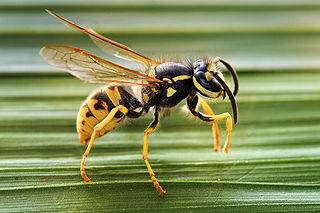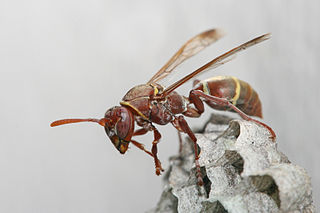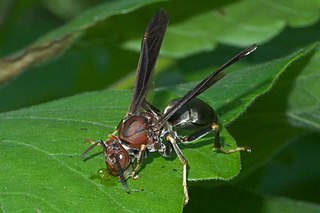
The Vespidae are a large, diverse, cosmopolitan family of wasps, including nearly all the known eusocial wasps and many solitary wasps. Each social wasp colony includes a queen and a number of female workers with varying degrees of sterility relative to the queen. In temperate social species, colonies usually last only one year, dying at the onset of winter. New queens and males (drones) are produced towards the end of the summer, and after mating, the queens hibernate over winter in cracks or other sheltered locations. The nests of most species are constructed out of mud, but polistines and vespines use plant fibers, chewed to form a sort of paper. Many species are pollen vectors contributing to the pollination of several plants, being potential or even effective pollinators, while others are notable predators of pest insect species.

Paper wasps are vespid wasps that gather fibers from dead wood and plant stems, which they mix with saliva, and use to construct nests made of gray or brown papery material. Some types of paper wasps are also sometimes called umbrella wasps, due to the distinctive design of their nests.

Wasps of the cosmopolitan genus Polistes are the most familiar of the polistine wasps, and are the most common type of paper wasp in North America. Walter Ebeling coined the vernacular name "umbrella wasps" for this genus in 1975 to distinguish it from other types of paper wasp, in reference to the form of their nests. It is also the single largest genus within the family Vespidae, with over 300 recognized species and subspecies. Their innate preferences for nest-building sites leads them to commonly build nests on human habitation, where they can be very unwelcome; although generally not aggressive, they can be provoked into defending their nests. All species are predatory, and they may consume large numbers of caterpillars, in which respect they are generally considered beneficial. The European paper wasp, Polistes dominula, was introduced into the US about 1981 and has quickly spread throughout most of the country, in most cases replacing native species within a few years. This species is very commonly mistaken for a yellow jacket, as it is black, strongly marked with yellow, and quite different from the native North American species of Polistes. The cuckoo wasp, Polistes sulcifer, is an obligate social parasite, whose only host is P. dominula. Polistes annularis, whose species name is Latin for "ringed", is also known for its distinctive red body color. Polistes metricus adults malaxate their insect prey by chewing them into a pulp, sucking out and ingesting the body fluids, then feeding the rest of the morsel to their larvae. The most widely distributed South American wasp species, Polistes versicolor, is particularly common in the southeastern Brazilian states. This social wasp is commonly referred to as the yellow paper wasp due to the distinct yellow bands found on its thorax and abdomen. Polistes wasps can be identified by their characteristic flight; their long legs dangle below their bodies, which are also more slender than a yellow jacket.

The Polistinae is a subfamily of eusocial wasps belonging to the family Vespidae. They are closely related to the more familiar wasps and true hornets of the subfamily Vespinae, containing four tribes. With about 1,100 species total, it is the second-most diverse subfamily within the Vespidae, and while most species are tropical or subtropical, they include some of the most frequently encountered large wasps in temperate regions.

Incilius fastidiosus, or the Pico Blanco toad, is a species of toad from western Panama and southeastern Costa Rica. It inhabits premontane and lower montane rainforest. It is largely a fossorial species that breeds explosively in temporary pools after heavy rains in late April–May. Juveniles occur on rocky stream margins the year round.
Oophagy sometimes ovophagy, literally "egg eating", is the practice of embryos feeding on eggs produced by the ovary while still inside the mother's uterus. The word oophagy is formed from the classical Greek ᾠόν and classical Greek φᾱγεῖν. In contrast, adelphophagy is the cannibalism of a multi-celled embryo.

The European paper wasp is one of the most common and well-known species of social wasps in the genus Polistes. Its diet is more diverse than that of most Polistes species—many genera of insects versus mainly caterpillars in other Polistes—giving it superior survival ability compared to other wasp species during a shortage of resources.

Polistes gallicus is a fairly common species of paper wasp found in various parts of Europe, excluding England, Denmark, and Scandinavia, from warmer climates to cooler regions north of the Alps. Nests of these social insects are created in these various conditions. The Polistes species use an oral secretion to construct their nests, which consist of a combination of saliva and chewed plant fibers. This structural mixture physically protects the nest from various harsh elements and from weathering over time.

Polistes metricus is a wasp native to North America. In the United States, it ranges throughout the southern Midwest, the South, and as far northeast as New York, but has recently been spotted in southwest Ontario. A single female specimen has also been reported from Dryden, Maine. Polistes metricus is dark colored, with yellow tarsi and black tibia. Nests of Polistes metricus can be found attached to the sides of buildings, trees, and shrubbery.
Copelatus fastidiosus is a species of diving beetle. It is part of the genus Copelatus in the subfamily Copelatinae of the family Dytiscidae. It was described by Félix Guignot in 1959.

Polistes exclamans, the Guinea paper wasp, is a social wasp and is part of the family Vespidae of the order Hymenoptera. It is found throughout the United States, Mexico, the Bahamas, Jamaica and parts of Canada. Due to solitary nest founding by queens, P. exclamans has extended its range in the past few decades and now covers the eastern half of the United States, as well as part of the north. This expansion is typically attributed to changing global climate and temperatures. P. exclamans has three specific castes, including males, workers, and queens, but the dominance hierarchy is further distinguished by age. The older the wasp is, the higher it is in ranking within the colony. In most P. exclamans nests, there is one queen who lays all the eggs in the colony. The physiological similarities between the worker and queen castes have led to experiments attempting to distinguish the characteristics of these two castes and how they are determined, though males have easily identifiable physiological characteristics. Since P. exclamans live in relatively small, open combed nests, they are often subject to predators and parasites, such as Chalcoela iphitalis, Elasmus polistis, and birds. P. exclamans have defense and recognition strategies that help protect against these predators and parasites.

Polistes carnifex is a neotropical vespid wasp in the cosmopolitan genus Polistes, known for its extremely painful and potent sting. The wasp is native to Central and South America. It is a very large yellow and brown paper wasp that establishes small colonies which build nests under the eaves of buildings or suspended from branches. The colonies are founded by solitary queens. Not all nests have a female with developed ovaries. Foraging adults bring nectar and macerated prey back to the nest to feed to the developing larvae which are individually housed in separate cells in the nest. It has mandibles with teeth.

Polistes nimpha is a eusocial paper wasp found all over Europe, with particular sightings in Turkey, Finland, Estonia, and Latvia. It is also found in northern Africa, Pakistan, Iran, India, Kazakhstan, Mongolia, and China. The climate in these areas is relatively cold and snowy in the winter, while summers are usually hot and dry, with steppe vegetation. Polistes nimpha colonies are relatively small and easily manipulated.
Polistes semenowi is a kleptoparasitic paper wasp that is found in several regions of high altitude in Europe. As one of only three obligate parasites in the genus Polistes, it uses the nests of other paper wasps to rear its young. To evade detection by the host nest, P. semenowi employs mimicry by adjusting its cuticular hydrocarbons to match those of the host. Once the host nest has been infiltrated, the parasitic female physically attacks the host queen to subdue her and become the colony's new queen. P. semenowi displays several morphological adaptations for parasitism such as increased mandible size and an enlarged Van der Vecht's organ. This species is unusual because it does not have the ability to produce workers and is only able to produce individuals who have the capacity to reproduce..
The name cuckoo paper wasp refers to a monophyletic species group of brood-parasitic paper wasps in the genus Polistes. This species group contains only three species; Polistes atrimandibularis, P. semenowi, and P. sulcifer, all of them obligate social parasites on other Polistes species.

Polistes parametricus is a species of paper wasp described in 2012. It was previously recognized as belonging in P. fuscatus-group. It is listed in the Identification Atlas of the Vespidae of the Northeastern Nearctic Region as "species B". And in the NCBI Taxonomy as Polistes sp. Buck2.
Clyzomedus fastidiosus is a species of beetle in the family Cerambycidae. It was described by Jean Baptiste Boisduval in 1835, originally under the genus Acanthocinus. It is known from Papua New Guinea, Indonesia, and the Philippines.
Alicyclobacillus fastidiosus is a species of Gram positive, strictly aerobic, bacterium. The bacteria are acidophilic and produce endospores. It was first isolated from apple juice. The species was first described in 2007, and the name refers to the fastidious nature of the organism; the bacteria would start to die off after 7 days when plated on typical agar for isolating Alicyclobacillus. Additionally, the species produced fewer spores than other members of its genus, and took much longer to produce the spores.

Polistes associus is a species of paper wasps belonging to the family Vespidae.

Polistes lanio is a species of paper wasp and one of several species in the subgenus Polistes (Aphanilopterus) known as a jack Spaniard wasp.














